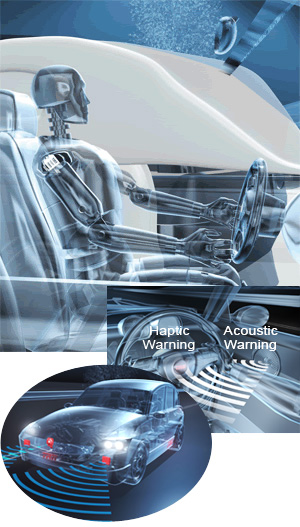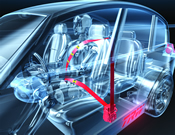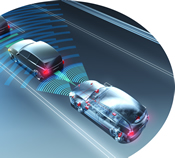
By integrating “active” safety systems, which are those that help avoid accidents, and “passive” safety systems, which help mitigate the effects of an accident, not only are new and enhanced levels of automotive safety possible, they are being achieved today.
Combining TRW’s unique position in both active and passive safety with its market leadership in sensors and sophisticated electronics has placed the company in an ideal position to bring these safety advancements to the market.
TRW is focusing its integrated safety efforts on technology combinations that offer the greatest potential to enhance the safety of drivers and passengers. Over the next few pages, we demonstrate just how far vehicle safety has come and how much the state of the art is accelerating. A number of products shown are in vehicles today; all can be production-ready in this decade.

Adaptive Cruise Control – Adaptive cruise control is a key enabling technology for integrating active and passive safety. The illustrations (above right and below left) show a center-mounted long-range radar and two outboard located short-range radars working together to monitor what’s happening in front of the vehicle from the total width of the front bumper to vehicles moving 150 or more meters ahead. Working in combination with a vehicle’s braking and engine management systems, these sensors can help manage a vehicle’s speed and interval from the leading car at highway speeds as well as in stop-and-go traffic, without the driver ever having to touch the pedals.

Collision Warning and Preparation – With short- and long-range radar systems on board, the adaptive cruise control system evolves from a convenience system to a true safety system, capable of detecting objects in close proximity and warning the driver (above center) by producing an audible warning or a haptic one, such as a programmed vibration of the steering wheel or seat cushion. In addition to warning the driver to take action, the brake system can be pre-armed to provide maximum brake boost once the driver does engage the brakes, resulting in reduced stopping distances (left). In addition, the reversible electric motor in TRW’s active control retractor seat belts (above right) can be signaled to remove the seat belt slack and better position the vehicle’s occupants for a potential crash. |